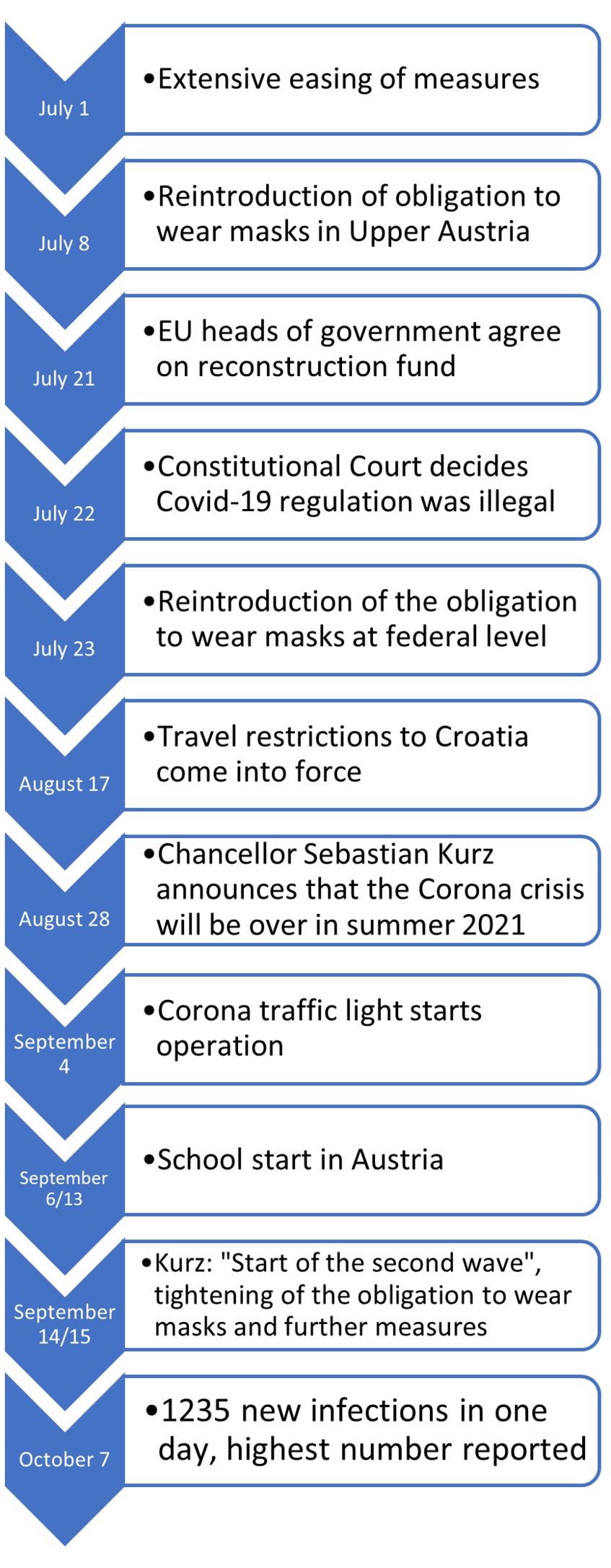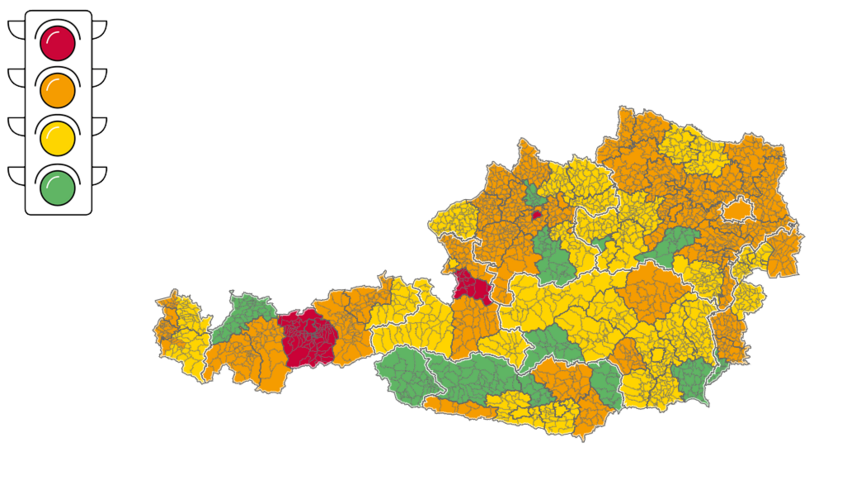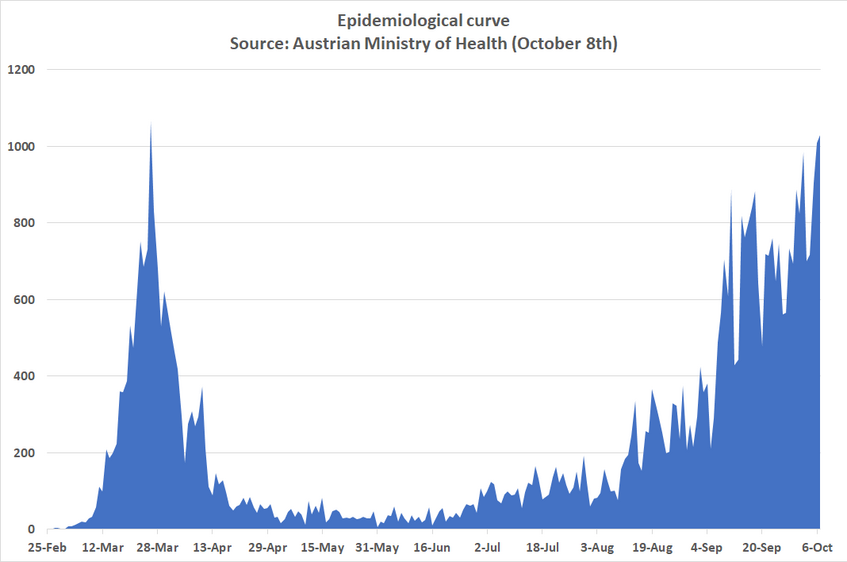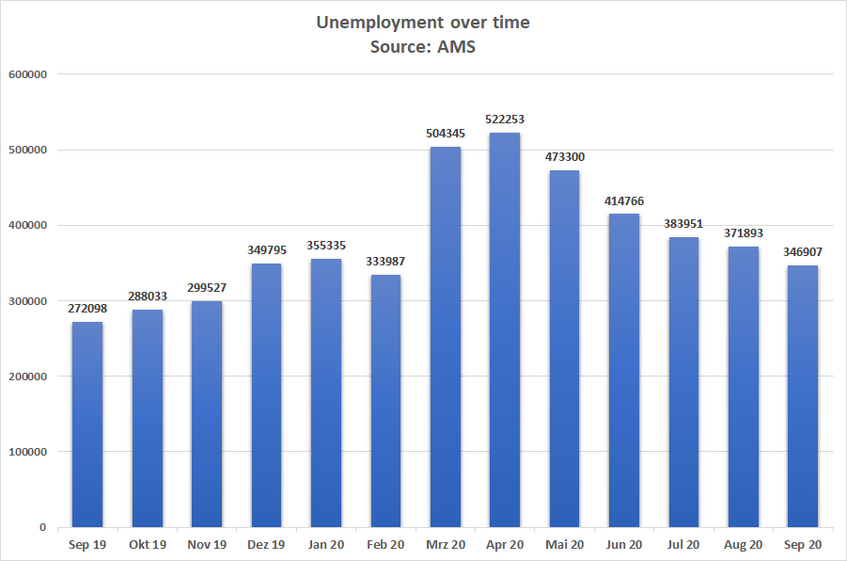22.10.2020
Chronology of the Corona Crisis in Austria - Part 3: A calm summer and the beginning of the second wave
- During the summer months, the infection dynamics were characterized by the emergence of regional clusters and travel returnees, which led to the reintroduction of measures such as the obligation to wear masks and increased testing.
- An agreement on crisis financing was reached on EU level, which Austria, as a member of the so-called "frugal four", also agreed to. Despite the massive economic recession, the labor market recovered significantly, but fell short of the previous year's figures.
- The second wave of the pandemic started at the beginning of autumn. Despite further tightening of measures and the introduction of monitoring instruments such as the Corona traffic light, the number of infections rose continuously.
By Markus Pollak, Nikolaus Kowarz and Julia Partheymüller
Austria experienced a comparatively calm summer after the dramatic restrictions of public life in spring (see part 1 of the Corona Chronology). Already from mid-April to the end of June 2020, numerous measures were lifted, which increasingly normalized public life (see part 2 of the Corona Chronology). This contribution to the Chronology of the Corona Crisis deals with the events and measures from July to the beginning of October. Moreover, we examine the infection dynamics and the situation on the labor market.
July: Regional clusters, reintroduction of compulsory masks and European crisis financing
After reaching the lowest level of reported new infections per day since the beginning of the crisis on May 31 (5 reported infections), the number of cases increased slightly since June. This development was initially mainly attributed to isolated clusters in churches and slaughterhouses in Upper Austria. On July 1, the last decree to easen measures came into force and a number of restrictions in the areas of gastronomy, events and sports were lifted: For instance, as of July 1, employees in the gastronomy sector no longer had to wear masks, significantly larger events were permitted, prostitution was allowed again, and the first long-haul flights of AUA took off after three months of flight cancellations. However, on this day, for the first time since April, more than 100 new infections were reported on one day.
Considering the increasing number of cases due to several clusters, the obligation to wear masks in restaurants and shops was finally reintroduced as of July 9 by decree of the state government in Upper Austria. This measure represented the first tightening of measures since the gradual strategy to easen measures had begun in April. Initially, Federal Chancellor Sebastian Kurz ruled out such a further tightening on federal level. Finally, however, due to the continued increase in the number of cases, the nationwide obligation to wear masks in supermarkets, banks and post offices was reintroduced on July 23 - only 38 days after the corresponding easing of the measure.
Two days earlier, the EU member states had agreed on the long awaited seven-year Multiannual Financial Framework (MFF) of the European Union, which for the first time was negotiated without the United Kingdom. The negotiations focused on how to deal with the Corona crisis. States such as Italy and Spain, which were particularly hit by the crisis, are supposed to get easier access to loans and will receive subsidies. As part of the so-called "frugal four", Federal Chancellor Sebastian Kurz was a critic of to the EU plans. 750 billion euros (360 billion loans, 390 billion grants) were finally budgeted for a joint "reconstruction fund" to help the member states during the crisis.
On 22 July, a ruling by the Constitutional Court declared several Covid-19 regulations unconstitutional and repealed them. Among other measures, the general curfew during the lockdown and the associated fines were illegal.
August: Travel returnees, rise of case numbers and the Corona traffic light
The possibility of holding large events in Austria has been discussed repeatedly. Finally, on August 1, the opening of the ´Salzburger Festspiele´ (Salzburg Festival) took place under considerable security restrictions. The cultural sector and media observed the event with regard to autumn, which may be affected by the pandemic. However, that the festival could still take place while observing hygiene measures showcased the comparatively relaxed situation in summer
In August, the number of new infections reported daily began to rise rapidly. At the beginning of August, an infection cluster was identified at St. Wolfgang. On August 14, Health Minister Rudolf Anschober saw a "historic mark exceeded", as one million tests had been carried out in Austria since the beginning of the crisis. According to Anschober, the high number of tests had an impact on case numbers: Because if more tests are carried out, more infections can be detected. Furthermore, the age structure of the group of infected persons in Austria has changed. In contrast to the beginning of the corona crisis, many young people have been affected since, especially between the ages of 15 and 24. Since younger people are more likely to experience a milder course of the disease, mortality has also fallen significantly.
Furthermore, the risk of infection from travel returnees, especially from Croatia, moved to the center of public debate. Finally, after an increase of infection cases linked to travels to Croatia, a decree of the Ministry of Health introducing travel restrictions came into force on August 17. The new restrictions led to vacation cancellations and traffic jams at the border. The city of Vienna set up a special ´testing street´ for travel returnees. Federal Chancellor Sebastian Kurz then declared that the "virus comes to Austria by car".
The dynamics of reported infections intensified increasingly; in the second half of the month, between 300 and 400 new infections were detected per day. However, growth remained relatively stable compared to the rapid increase in March. Moreover, on August 28, Federal Chancellor Sebastian Kurz announced that there was "light at the end of the tunnel" and that the Corona Crisis would be over by the upcoming summer (2021).
September and early October: The start of the second wave, the Corona traffic light and more measures
Infection numbers continued to rise in September, which led to the renewed implementation of travel restrictions. Hungary already closed its borders to international tourists on September 1, which also affected Austrians. A bit later, first Switzerland and then Germany declared Vienna (later also Tyrol) a risk area, which meant that travels to these countries were only possible with a negative corona test result or by quarantining.
Directly before the start of the school year, the corona traffic light was put into operation on September 4, which publishes regional risk assessments (green, yellow, orange, red) based on recommendations of the Corona Commission. It was designed to provide information on which regions in Austria are currently particularly at risk (see Figure 2). Since then, it has been widely criticized for the alleged political influence on the color of the traffic lights and the lack of binding mechanisms to enforce measures associated with the assessment.
Figure 2: Corona traffic light of the Austrian Ministry of Health, status: 15.10.2020 (Source: corona-ampel.gv.at)
The daily confirmed new infections increased drastically in the first half of September, as shown in the epidemiological curve (Figure 5). Within a few days, the number of cases increased from 200 to 400 per day to 600 to 800. For the first time since the peak of the first wave, more than 1,000 new infections (1058) were reported on October 3 in a single day. On October 8, according to the epidemiological curve, as many as 1,235 persons were infected in Austria - the highest daily number ever reported in Austria [1].
However, the comparability of the infection figures with the first phase of the crisis is limited due to the significantly larger number of tests (October 8: 20,000). The effective reproduction number "R", which indicates the average number of people infected by one infected person, was 1.13 at the beginning of October, whereas it was about 3 when the lockdown was announced in March. The development in March was thus characterized by a much more rapid relative spread (more about the calculation method of R here).
Figure 3: Epidemiological curve (reported new infections per day), (source: covid19-dashboard.ages.at)
On September 12, the Austrian federal government reacted to the rising number of infections with a renewed tightening of measures. A press release from the Federal Chancellery announced on September 13 that the second wave of the pandemic had begun. A decree of the Ministry of Health, which came into force on September 14, extended the obligation to wear masks and tightened the requirements in the event sector. Public meetings with more than 10 people were prohibited from 21 September. In addition, from September 28, a new compulsory registration of visitors in the gastronomy was introduced in Vienna.
The Corona Pandemic continued to have considerable economic consequences for Austria. On September 28, Statistik Austria announced that the 12.1% decrease in gross domestic product (GDP) in the second quarter of 2020 was the "most severe decline since the Second World War". Although the labor market had recovered significantly during the summer months, according to the Austrian Labor Market Service (AMS), unemployment figures in September were nevertheless well above the previous year's level (Figure 4).
Summary and conclusion
Austria experienced a - compared to the lockdown in spring - calm summer. After a long debate, an agreement on European crisis financing was reached on European level, which Austria, as a member of the group of the "frugal four", agreed to as well. Despite the dramatic economic decline, the labor market recovered significantly in the summer months, even if the previous year's level has not yet been reached again. However, the infection dynamics accelerated increasingly by the beginning of autumn. While regional clusters and travel returnees were mainly responsible for the increase in infections in the summer, infection figures rose in broader population groups in early fall. The Federal Government attempted to stop the spread of the disease with targeted measures by reintroducing restrictions that had initially been lifted and by placing greater emphasis on testing of travel returnees. In addition, new regional control instruments such as the Corona traffic light were developed, but they probably had little control effect so far, presumably because they are not linked to mandatory measures. The Austrians were recently facing the beginning of the second wave and the "light at the end of the tunnel" in mid 2021 is currently still out of sight.
Markus Pollak works as student assistant at the Institute for Economic Sociology at the University of Vienna on the Austrian Corona Panel Project. He is studying political science for his Master's degree.
Nikolaus Kowarz works as student assistant at the Institute of Governance at the University of Vienna and is studying Political Science for his Master's degree.
Julia Partheymüller works as Senior Scientist at the Vienna Center for Electoral Research (VieCER) at the University of Vienna and is a member of the project team of the Austrian National Election Study (AUTNES). She received her doctorate in social sciences at the University of Mannheim and studied political science at the Free University of Berlin and the University of Hamburg.
Footnotes
[1] All data on confirmed infections, deaths and growth rates in this article refers to the official data and the calculation method of the Austrian Ministry of Health, the Austrian agency for health and food security GmbH as well as to the AGES Dashboard COVID 19: https://covid19-dashboard.ages.at/?l=en
The figures may therefore differ from those of other sources. e.g. COVID-19 Dashboard by the Center for Systems Science and Engineering (CSSE) at Johns Hopkins University (JHU): https://coronavirus.jhu.edu/map.html
Related Blog Posts
Chronology
- February - March 2020: Blog 51 (EN) - Chronology of the Corona Crisis in Austria - Part 1: Background, the way to the lockdown, the acute phase and economic consequences
- April - June 2020: Blog 60 (EN) - Chronology of the Corona Crisis in Austria - Part 2: From the first easing of measures towards restoring normality
- October 2020 - January 2021: Blog 100 (EN) - Chronology of the Corona Crisis in Austria - Part 4: Lockdowns, mass testing and the launch of the vaccination campaign
- February 2021 - May 2021: Blog 112 (EN) - Chronology of the Corona Crisis in Austria - Part 5: Third Wave, Regional Lockdowns and the Vaccination Campaign
- June - November 2021: Blog 135 (EN) - Chronology of the Corona Crisis in Austria - Part 6: A "summer like it used to be", the way to the fourth wave, another lockdown and a vaccine mandate
English Summaries
- COVID-19 affects us all — unequally. Lessons from Austria
- From Acute Crisis to Long-Term Coping?
- The Coronation of Austria: Part 3
- The Coronation of Austria, Part 4
- The Coronation of Austria, Part 5: Time for a syndemic perspective?
- The Coronation of Austria: Part 6
- The Coronation of Austria: Part 7
- The Coronation of Austria: Part 8
- The Coronation of Austria, Part 9: Postal Votes, Polarisation, and Protecting Others




